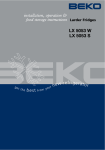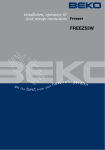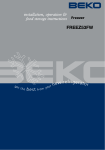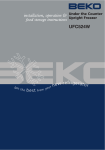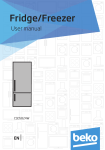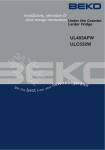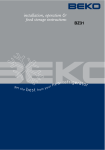Download Beko BR 11 Instruction manual
Transcript
Buılt Under Integrated Refrigerator BR 11 Please read this manual first! Dear Customer, We hope that your product, which has been produced in modern plants and checked under the most meticulous quality control procedures, will provide you with years of good service. For this, we recommend you to carefully read the entire manual of your product before using it and keep it at hand for future reference. • This manual will help you use your appliance quickly and safely. • Read the manual before installing and operating your product. • Follow the instructions, especially those about safety warnings. • Keep the manual in an easily accessible place as you may need it later. • Also read the other documents provided with your product. Symbols and their descriptions This instruction manual contains the following symbols: C Important information or useful usage tips. A Warning against dangerous conditions for life and property. B Warning against electric voltage shock. Recycling This product is supplied with the selective sorting symbol for waste electrical and electronic equipment (WEEE). This means that this product must be handled pursuant to European Directive 2002/96/EC in order to be recycled or dismantled to minimise its impact on the environment. For further information, please contact your local or regional authorities. Electronic products not included in the selective sorting process are potentially dangerous for the environment and human health due to the presence of hazardous substances. CONTENTS 1 Your refrigerator 3 5 Using your refrigerator 20 2 Warnings 4 Cooling.............................................21 Thermostat setting button................20 Electrical Requirements......................5 Warning! This Appliance Must Be Earthed..............................................5 Energy Saving Tips.............................6 3 Installation 7 6 Maintenance and cleaning Points to be considered when retransporting your refrigerator..............7 Before operating your refrigerator.......7 Disposing of the packaging................8 Disposing of your old refrigerator........8 Placing and Installation.......................8 Replacing the interior light bulb . ........9 Reversing the doors.........................10 Reversing the doors.........................12 4 Preparation Freezing............................................21 Defrost.............................................21 Stopping your product......................22 Temperature Control And Adjustment.23 7 Do's and Don'ts 25 8 GUARANTEE DETAILS 26 9 HOW TO OBTAIN SERVICE 19 2 24 EN 27 1 Your refrigerator 6 1 5 2 2 3 4 7 1. To freeze fresh food, frozen food, rapid cooling of beverages, making ice cubes. 2. Baked, chilled cooked food, dairy products. 3. 4. 5. 6. 7. Meat, sausages, cold cuts, cans. Fruit, vegetables, salads. Tubes, small bottles and cans. Egg tray. Beverages, large bottles. C Figures that take place in this instruction manual are schematic and may not correspond exactly with your product. If the subject parts are not included in the product you have purchased, then it is valid for other models. 3 EN 2 Warnings •DO NOT connect your appliance to the electricity supply until all packing and transit protectors have been removed. • Leave to stand for at least 4 hours before switching on to allow compressor oil to settle if transported horizontally. • If you are discarding an old refrigerator with a lock or latch fitted to the door, disable the lock/latch, ensure that it is left in a safe condition to prevent the entrapment of young children. • This fridge/freezer must only be used for its intended purpose i.e the storing and freezing of edible foodstuff. • Do not dispose of the appliance on a fire. At BEKO, the care and protection of our environment is an ongoing commitment. This appliance which is among the latest range introduced is particularly environment friendly. Your appliance contains non CFC / HFC natural substances in the cooling system (Called R600a) and in the insulation (Called cyclopentane) which are potentially flammable if exposed to fire. Therefore, take care not to damage, the cooling circuit / pipes of the appliance in transportation and in use. In case of damage do not expose the appliance to fire or potential ignition source and immediately ventilate the room where the appliance is situated. • We suggest you contact your local authority for disposal information and facilities available. • See Installation Instructions on on page 8 for information on suitable location. 4 • To obtain the best possible performance and trouble free operation from your appliance it is very important to carefully read these instructions. • On delivery, check to make sure that the product is not damaged and that all the parts and accessories are in perfect condition. • Ensure that the plug remains readily accessible. Do not use multiple adapter bar or extension cable. • Failure to observe these instructions may invalidate your right to free service during the guarantee period. • Keep ventilation openings, in the appliance enclosure or in the built-in structure, clear of obstruction. • Do not use mechanical devices or other means to accelerate the defrosting process, other than those recommended by the manufacturer. • Do not damage the refrigerant circuit. • Do not use electrical appliances inside the food storage compartments of the appliance, unless they are of the type recommended by the manufacturer. • We suggest you keep these instructions in a safe place for easy reference. • This appliance is not intended for use by persons (including children) with reduced physical, sensory or mental capabilities, or lack of experience and knowledge, unless they have been given supervision or instruction concerning use of the appliance by a person responsible for their safety. • Children should be supervised to ensure that they do not play with the appliance. EN 6mm. 22mm. CORD GRIP EN FUSE N BLUE OR BLACK L BROWN OR RED FITTED WITH BS 1362 13A FUSE ALWAYS FIT BS 1362 REPLACEMENT CARTRIDGE FUSE GREEN & YELLOW OR GREEN 6mm. If the fitted moulded plug is not suitable for your socket, then the plug should be cut off and an appropriate plug fitted. Destroy the old plug which is cut off as a plug with bared cord could cause a shock hazard if inserted into a socket elsewhere in the house. The moulded plug on this appliance incorporates a 13 A fuse. Should the fuse need to be replaced an ASTABEAB approved BS 1362 fuse of the same rating must be used. Do not forget to refit the fuse cover. In the event of losing the fuse cover the plug must not be used until a replacement fuse cover has been fitted. Colour of the replacement fuse cover must be the same colour as that visible on the pin face of the plug. Fuse covers are available from any good electrical store. 5 12mm. Warning! This Appliance Must Be Earthed Important! Fitting A Different Plug As the colours of the wires in the mains lead of this appliance may not correspond with the coloured markings identifying the terminals in your plug proceed as follows: (See diagram). Connect the green-yellow or green.1 (Earth) wire to the terminal in the plug marked ‘E’ or with the symbol or coloured green and yellow or green. Connect the blue (Neutral) wire to.2 the terminal in the plug marked ‘N’ or coloured black. Connect the brown (Live) wire to.3 the terminal in the plug marked ‘L’ or coloured red. With alternative plugs a 13 A fuse must be fitted either in the plug or adaptor or in the main fuse box. If in doubt contact a qualified electrician. 32mm. Before you insert the plug into the wall socket make sure that the voltage and the frequency shown on the rating plate inside the appliance corresponds to yourelectricity supply. Rating label is on the left hand side of fridge inner liner. We recommend that this appliance be connected to the mains supply via a suitable switched and fused socket. The appliance must be positioned so that the plug is accessible. Should the mains lead of the appliance become damaged or should it need replacing at any time, it must be replaced by a special purpose made mains lead which can only be obtained from a BEKO Authorised Service Agent. 6mm. Electrical Requirements Energy Saving Tips 1- Ensure your appliance is installed in a well ventilated area. 2- Ensure the time between buying chilled/frozen food and placing them in your appliance is kept at minimum, particularly in summer. We recommend you use a cool bag or a special carrier bag to carry frozen food. 3- Do not leave the door (s) of your appliance open longer than necessary and ensure they are closed properly after each opening. 4- Defrost frozen food in the fridge compartment, so that frozen food acts as an ice pack to assist cooling in the fridge. 6 EN 3 Installation BPlease remember that the manufacturer shall not be held liable if the information given in the instruction manual is not observed. Points to be considered when re-transporting your refrigerator 1. Your refrigerator must be emptied and cleaned prior to any transportation. 2. Shelves, accessories, crisper and etc. in your refrigerator must be fastened securely by adhesive tape against any jolt before repackaging. 3. Packaging must be tied with thick tapes and strong ropes and the rules of transportation printed on the package must be followed. Please do not forget… Every recycled material is an indispensable source for the nature and for our national resources. If you wish to contribute to recycling the packaging materials, you can get further information from the environmental bodies or local authorities. Before operating your refrigerator Before starting to use your refrigerator check the following: 1. Is the interior of the refrigerator dry and can the air circulate freely in the rear of it? 2. Clean the interior of the refrigerator as recommended in the “Maintenance and cleaning” section. 7 3. Plug the refrigerator into the wall outlet. When the fridge door is open the fridge compartment interior light will come on. 4. You will hear a noise as the compressor starts up. The liquid and gases sealed within the refrigeration system may also give rise to noise, even if the compressor is not running and this is quite normal. 5. Front edges of the refrigerator may feel warm. This is normal. These areas are designed to be warm to avoid condensation. Electric connection Connect your product to a grounded socket which is being protected by a fuse with the appropriate capacity. Important: • The connection must be in compliance with national regulations. • The power cable plug must be easily accessible after installation. • The specified voltage must be equal to your mains voltage. • Extension cables and multiway plugs must not be used for connection. BA damaged power cable must be replaced by a qualified electrician. BProduct must not be operated before it is repaired! There is danger of electric shock! EN Disposing of the packaging Placing and Installation The packing materials may be dangerous for children. Keep the packing materials out of the reach of children or dispose them of by classifying them in accordance with the waste instructions. Do not dispose them of along with the normal household waste. The packing of your refrigerator is produced from recyclable materials. 1. Install your refrigerator to a place that allows ease of use. 2. Keep your refrigerator away from heat sources, humid places and direct sunlight. 3. There must be appropriate air ventilation around your refrigerator in order to achieve an efficient operation. If the refrigerator is to be placed in a recess in the wall, there must be at least 5 cm distance with the ceiling and at least 5 cm with the wall. If the floor is covered with a carpet, your product must be elevated 2.5 cm from the floor. 4. Place your refrigerator on an even floor surface to prevent jolts. 5. Do not keep your refrigerator in ambient temperatures under 10°C. Disposing of your old refrigerator Dispose of your old machine without giving any harm to the environment. • You may consult your authorized dealer or waste collection center of your municipality about the disposal of your refrigerator. Before disposing of your refrigerator, cut out the electric plug and, if there are any locks on the door, make them inoperable in order to protect children against any danger. 8 EN Replacing the interior light bulb Should the light fail to work switch off at the socket outlet and pull out the mains plug. Follow the below instructions to check if the light bulb has worked itself loose. If the light still fails to work obtain a replacement E14 screw cap type 15 Watt (Max) bulb from your local electrical store and then fit it as follows: 1. Switch off at the socket outlet and pull out the mains plug. You may find it useful to remove shelves for easy access. 2. Remove the light diffuser cover as shown in figure (a-b). 3. Replace the burnt-out light bulb. 4. Reassemble the light diffuser cover as shown in figure (c). “Push firmly to ensure cover is fitted properly.” 5. Carefully dispose of the burnt-out light bulb immediately. “Replacement light bulb can easily be obtained from a good local electrical or DIY store.” 9 EN Reversing the doors Follow the step by step instructions and the diagram below. Numbers in brackets refer to diagrams. 1 1 3 2 2 4 5 8 8 6 7 7 10 EN 1. Switch off at the socket outlet and pull out the mains plug. 2. Remove all food, loose items and fittings from inside the appliance and door shelves. 3. Unscrew the bolts and remove the upper and bottom hinges from the cabinet and door. (1) (2) 4. Remove stoppers. (3) (4) 5. Fit the stoppers on the opposite side. (5) (6) 6. Reposition the upper hinge on the opposite side as bottom hinge (7) 7. Reposition the bottom hinge on the opposite side as upper hinge. (8) Locate the door and tighten the bolts fixing the door. To change door from R/H to L/H please follow procedure below: 1. Carefully remove the lower then the upper Torx screws that hold the door to the hinges. 2. Open hinges fully then carefully remove the self tap countersunk screws holding the hinges to the cabinet. 3. Remove the plastic covers from the L/H hinge fixing points and carefully re insert in the R/H holes. 4. Carefully place the self tap screws into the new fixing points applying gentle pressure until they start to bite (at this point it may help to have someone at the back of appliance to support). 5. For ease of fixing we recommend screwing all the way in, and then ease back out. 6. Re fit hinge 7. Tighten the screws firmly. 8. Re fit door, loosely fixing the top screws first, and then fit the lower screws. 9. When all screws fitted; tighten firmly and check door for alignment. 11 EN Reversing the doors C A D B 1 1 3 2 2 4 E F G 5 8 8 6 7 7 12 EN 13 EN 14 EN 15 EN 16 EN 17 EN 18 EN 4 Preparation C Your refrigerator should be installed at least 30 cm away from heat sources such as hobs, ovens, central heater and stoves and at least 5 cm away from electrical ovens and should not be located under direct sunlight. C The ambient temperature of the room where you install your refrigerator should at least be 10°C. Operating your refrigerator under cooler conditions than this is not recommended with regard to its efficiency. C Please make sure that the interior of your refrigerator is cleaned thoroughly. C If two refrigerators are to be installed side by side, there should be at least 2 cm distance between them. C When you operate your refrigerator for the first time, please observe the following instructions during the initial six hours. - The door should not be opened frequently. - It must be operated empty without any food in it. - Do not unplug your refrigerator. If a power failure occurs out of your control, please see the warnings in the “Recommended solutions for the problems” section. C Original packaging and foam materials should be kept for future transportations or moving. 19 EN 5 Using your refrigerator Thermostat setting button The operating temperature is regulated by the temperature control. Warm 1 (Or) Min. Cold 2 3 4 5 Max. 1 = Lowest cooling setting (Warmest setting) 5 = Highest cooling setting (Coldest setting) (Or) Min. = Lowest cooling setting (Warmest setting) Max. = Highest cooling setting (Coldest setting) The average temperature inside the fridge should be around +5°C. Please choose the setting according to the desired temperature. Please note that there will be different temperatures in the cooling area. The coldest region is immediately above the vegetable compartment. The interior temperature also depends on ambient temperature, the frequency with which the door is opened and the amount of foods kept inside. 20 Frequently opening the door causes the interior temperature to rise. For this reason, it is recommended to close the door again as soon as possible after use. The interior temperature of your refrigerator changes for the following reasons; • Seasonal temperatures, • Frequent opening of the door and leaving the door open for long periods, • Food put into the refrigerator without cooling down to the room temperature, • The location of the refrigerator in the room (e.g. exposing to sunlight). • You may adjust the varying interior temperature due to such reasons by using the thermostat. Numbers around the thermostat button indicates the cooling degrees. • If the ambient temperature is higher than 32°C, turn the thermostat button to maximum position. • If the ambient temperature is lower than 25°C, turn the thermostat button to minimum position. EN Cooling Defrost Food storage The fridge compartment is for the short-term storage of fresh food and drinks. A) Fridge compartment Fridge compartment performs fullautomatic defrosting. Water drops and a frosting up to 7-8 mm can occur on the inner rear wall of the fridge compartment while your refrigerator cools down. Such formation is normal as a result of the cooling system. The frost formation is defrosted by performing automatic defrosting with certain intervals thanks to the automatic defrosting system of the rear wall. User is not required to scrape the frost or remove the water drops. Water resulting from the defrosting passes from the water collection groove and flows into the evaporator through the drain pipe and evaporates there by itself. Check regularly to see if the drain pipe is clogged or not and clear it with the plunger provided when necessary. Deep freezer compartment does not perform automatic defrosting in order to prevent decaying of the frozen food. Freezing Freezing food The freezing compartment is marked with this symbol. You can use the appliance for freezing fresh food as well as for storing prefrozen food. The recommendation for storage, as stated on the food packaging, should be observed at all times. 21 EN B) Freezer compartment Defrosting is very straightforward and without mess, thanks to a special defrost collection basin. Defrost twice a year or when a frost layer of around 7 (1/4”) mm has formed. To start the defrosting procedure, switch off the appliance at the socket outlet and pull out the mains plug. All food should be wrapped in several layers of newspaper and stored in a cool place (e.g. fridge or larder). Containers of warm water may be placed carefully in the freezer to speed up the defrosting. Do not use pointed or sharp-edged objects, such as knives or forks to remove the frost. Never use hair dryers, electrical heaters or other such electrical appliances for defrosting. Sponge out the defrost water collected in the bottom of the freezer compartment. After defrosting, dry the interior thoroughly. Insert the plug into the wall socket and switch on the electricity supply. 22 Stopping your product If your thermostat is equipped with “0” position: - Your product will stop operating when you turn the thermostat button to “0” (zero) position. Your product will not start unless to you turn the thermostat button to position “1” or one of the other positions again. If your thermostat is equipped with “min” position: - Unplug your product to stop it. EN Temperature Control And Adjustment Operating temperatures are controlled by the thermostat (see diagram). Settings may be made from 1 to 5, the coldest position. When the appliance is switched on for the first time, the thermostat should be adjusted so that after 24 hours, the average fridge temperature is no higher than +5°C (+41°F). We recommend you set the thermostat halfway between the 1 and 5 setting and monitor to obtain the desired temperature i. e. towards 5 you will obtain a colder fridge temperature and vice versa. Some sections of the fridge may be cooler or warmer ( such as the salad crisper and the top part of the cabinet ) which is quite normal.Over ambient temperatures of 25°C (77°F) especially in summer turn the thermostat knob towards 5. Under ambient temperatures of 25°C (77°F) turn the thermostat knob to a half way position. Frequent door opening cause higher internal temperatures, so close the door as soon as possible after use.In case of a temporary ice build up in the fridge compartment reduce the thermostat setting to 1, monitoring at the same time that the fridge temperature is maximum +5 degrees C (41 degrees F). Once the ice build up disappears and the appliance starts auto defrosting again as normal, then you may increase the thermostat setting, if required. 23 EN 6 Maintenance and cleaning •We recommend that you switch off the appliance at the socket outlet and pull out the mains plug before cleaning. •If the freezer is not going to be used for a long period of time switch it off,remove all food, clean it and leave the door ajar. •Never use any sharp abrasive instrument, soap, household cleaner, detergent and wax polish for cleaning. •To remove a drawer, pull it as far as possible, and then tilt it upwards, and then pull it out completely. •Check door seals regularly to ensure they are clean and free from food particles.. •Never :Clean the worktop with unsuitable material; eg petroleum based products.Subject it to hot temperatures in any way, Scour, rub etc., with abrasive material. •Use luke warm water to clean the cabinet of the appliance and wipe it dry. •Use a damp cloth wrung out in a solution of one teaspoon of bicarbonate of soda to one pint of water to clean the interior and wipe it dry. •Excess deposit of ice should be removed on a regular basis using the handle of a spoon. Large accumulation of ice will impair the performance of the freezer. 24 EN 7 Do's and Don'ts Don’t-Store poisonous or any dangerous substances in the refrigerator. Your larder refrigerator has been designed for the storage of edible foodstuffs only. Don’t- Consume food which has been stored for an excessive time in the larder refrigerator. Don’t- Consume food which has been stored for an excessive time in the refrigerator. Don’t- Store cooked and fresh food together in the same container. They should be packaged and stored seperately. Don’t- Let defrosting food or food juices drip onto food in your refrigerator. Problem Solvıng If the appliance does not operate when switched on, check whether: •The plug is inserted properly in the socket and that the power supply is on. (To check the power supply to the socket, plug in another appliance) • The fuse has blown/circuit breaker has tripped/main distribution switch has been turned off. • The temperature control has been set correctly. • New plug is wired correctly if you have changed the fitted moulded plug. If the appliance is still not operating after the above checks, please refer to the section on “How To Obtain Service”. Please ensure that above checks have been made as a charge will be made if no fault is found. Do- Clean your appliance regularly (See “Cleaning and Care”) Do- Keep raw meat and poultry below cooked food and dairy products. Do-Keep food for as short a time as possible and adhere to ‘Best Before’ and “Use By” dates. Do- Take off any unusable leaves on vegetables and wipe off any soil. Do- Leave lettuce, cabbage, parsley and cauliflower on the stem. Do- Wrap cheese firstly in greaseproof paper and then in a polythene bag excluding as much air as possible. For best results take out of the fridge compartment an hour before eating. Do- Wrap raw meat and poultry loosely in polythene or aluminium foil. This prevents drying. Do- Wrap fish and offal in polythene bags. Do- Wrap food which have a strong odour or can dry out in polythene bags, aluminium foil or place in an airtight container. Do- Wrap bread well to keep it fresh. Do- Chill white wines, beer, lager and mineral water before serving. Don’t- Store bananas in your fridge. Don’t- Store melon in your fridge. It can be chilled for short periods as long as it is wrapped to avoid it flavouring other food. Don’t- Leave the door open for long periods as this will make the refrigerator more costly to run. 25 EN 8 GUARANTEE DETAILS GUARANTEE DETAILS Your new Beko product is guaranteed against the cost of breakdown repair for two years from the date of the original purchase. What is covered? • Repairs necessary as a result of faulty materials, defective components or manufacturing defect. • The cost of functional replacement parts, but excluding consumable items. • The labour costs of a Beko approved repairer to carry out the repair. What is not covered? • Transit, delivery or accidental damage or misuse and abuse. • Cabinet or appearance parts, including control knobs, flaps, handles or container lids. • Accessories or consumable items including but not limited to, ice trays, scrapers, cutlery baskets, filters and light bulbs. • Repairs required as a result of unauthorised repair or inexpert installation that fails to meet the requirements contained in the user instruction book. • Repairs to products used on commercial or non-residential household premises. • Loss of frozen food in freezers or fridge/freezers. (Food loss insurance is often included within your household contents insurance policy, or may be available separately from your retailer). Important notes. • Your Beko product is designed and built for domestic household use only. • The guarantee will be void if the product is installed or used in commercial or non-residential domestic household premises. • The product must be correctly installed, located and operated in accordance with the instructions contained in the User Instructions Booklet provided. • Professional installation by a qualified Electrical Domestic Appliance Installer is recommended for all Washing Machines, Dishwashers and Electric Cookers • Gas Cookers must only be installed by a Gas Safe (or BORD GAIS) registered Gas Installer. • The guarantee is given only within the boundaries of the United Kingdom and the Republic of Ireland. • The guarantee is applicable only to new products and is not transferable if the product is resold. • Beko disclaims any liability for incidental or consequential damages. The guarantee does not in anyway diminish your statutory or legal rights. 26 EN 9 HOW TO OBTAIN SERVICE HOW TO OBTAIN SERVICE Please keep your purchase receipt or other proof of purchase in a safe place; you will need to have it should the product require attention under guarantee. You should also complete the details below; it will help us assist you when requesting service. (The model number is printed on the Instruction Booklet and the serial number is printed on the Rating Label affixed to the appliance) Model No: Serial No: Retailer: Date of purchase: For service under guarantee simply telephone the appropriate number below UK Mainland & Northern Ireland Fridges & Freezers Electric Cookers Gas & Dual Fuel Cookers Washing Machines & Dishwashers 0845 6004903 0845 6004902 0845 6004905 0845 6004906 Republic of Ireland All Refrigeration, All Cookers Washing Machines & Dishwashers 01 862 3411 Before requesting service please check the trouble-shooting guide in the Operating Instructions as a charge may be levied where no fault is found even though your product may still be under guarantee. Service once the manufacturers guarantee has expired. If you have purchased an extended guarantee please refer to the instructions contained within the extended guarantee agreement document. Otherwise please call the appropriate number above where service can be obtained at a charge. Should you experience any difficulty in obtaining service please contact the Beko Customer Help-Line. Tel: 0845 6004911 e-mail: [email protected] 27 EN BEKO plc Beko House Caxton Way Watford Hertfordshire WD18 8UF Tel: 0845 6004911 Fax: 0845 6004922 e-mail: [email protected] website: www.beko.co.uk Printed in Turkey Part no: 57 0370 0000 Revision no: AE 28 EN






























